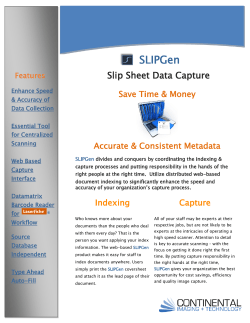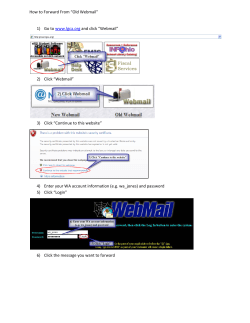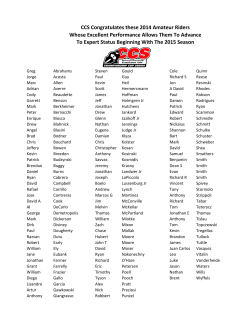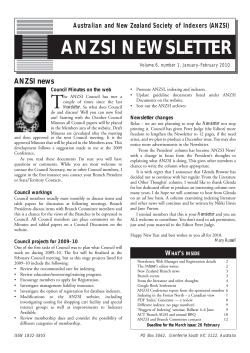
Indexing Standards Review Draft #2 Posted for Review November 13, 2014
2501 Aerial Center Parkway, Suite 103, Morrisville, NC 27560
877.997.7742
Indexing Standards
Review Draft #2
Posted for Review
November 13, 2014
Adopted by the PRIA Board on Month DD, YYYY
http://www.pria.us
Page 1 of 12
PRIA Copyright Notice, Disclaimer and Evaluation License
Version 1.0 April 2004 (the “PRIA Evaluation License” or the “Evaluation License”)
Copyright © 2014 - writers listed in the Incomplete Work (collectively or individually, a “Licensor”). All rights reserved.
This draft document (the “Incomplete Work”) is made available by the Property Records Industry Association (“PRIA”) to
Members and select members of the general public for review, evaluation and comment only, as it is not a final version of the
document under development. At the time such document is finalized, it shall be published in accordance with, inter alia,
PRIA Copyright Notice, Disclaimer and End-User License Version 1.1 November 2003, or any successor license.
Subject to this License, Licensor hereby grants any user of the Incomplete Work (“Licensee”) a worldwide, royalty-free, nonexclusive license to reproduce the Incomplete Work in copies, and to use the Incomplete Work and all such reproductions
solely for purposes of reviewing, evaluating and commenting upon the Incomplete Work. NO OTHER RIGHTS ARE
GRANTED UNDER THIS LICENSE AND ALL OTHER RIGHTS ARE EXPRESSLY RESERVED TO LICENSOR. Without
limiting the generality of the foregoing, Licensor does not grant any right to (i) prepare proprietary derivative works based
upon the Incomplete Work, (ii) distribute copies of the Incomplete Work to the public by sale or other transfer of ownership,
or (iii) display the Incomplete Work publicly. Comments on the Incomplete Work must be sent to PRIA as indicated at
www.pria.us.
Any reproduction of the Incomplete Work shall reproduce verbatim the above copyright notice, the entire text of this
Evaluation License and the entire disclaimer below under the following header:
This document includes Incomplete Works developed by PRIA and some of its contributors, subject to PRIA Evaluation
License, Version 1.0 April 2004 published at www.pria.us/license.htm or any subsequent applicable version of such License.
“PRIA” is a trade name of the “Property Records Industry Association.” No reference to PRIA or any of its trademarks by
Licensee shall imply endorsement of Licensee's activities and products.
DISCLAIMER: THIS INCOMPLETE WORK IS PROVIDED "AS IS.” PRIA, THE COPYRIGHT HOLDER, THE AUTHORS OF
THIS INCOMPLETE WORK AND ANY STANDARD -SETTING BODY CONTRIBUTORS TO THIS INCOMPLETE WORK
MAKE NO REPRESENTATIONS OR WARRANTIES (i) EXPRESS OR IMPLIED, INCLUDING, BUT NOT LIMITED TO,
WARRANTIES OF MERCHANTABILITY, FITNESS FOR A PARTICULAR PURPOSE, TITLE OR NON-INFRINGEMENT; (ii)
THAT THE CONTENTS OF SUCH INCOMPLETE WORK ARE FREE FROM ERROR OR SUITABLE FOR ANY PURPOSE;
NOR THAT IMPLEMENTATION OF SUCH CONTENTS WILL NOT INFRINGE ANY THIRD-PARTY PATENTS,
COPYRIGHTS, TRADEMARKS OR OTHER RIGHTS. IN NO EVENT WILL PRIA, THE COPYRIGHT HOLDER. ANY
AUTHOR OF THIS INCOMPLETE WORK, OR THE STANDARD-SETTING BODY CONTRIBUTORS TO THIS
INCOMPLETE WORK BE LIABLE TO ANY PARTY FOR ANY DIRECT, INDIRECT, SPECIAL OR CONSEQUENTIAL
DAMAGES FOR ANY USE OF THIS INCOMPLETE WORK, INCLUDING, WITHOUT LIMITATION, ANY LOST PROFITS,
BUSINESS INTERRUPTION, LOSS OF PROGRAMS OR OTHER DATA ON YOUR INFORMATION HANDLING SYSTEM
OR OTHERWISE, EVEN IF PRIA, THE COPYRIGHT HOLDER AND/OR ANY AUTHORS AND/OR ANY STANDARDSETTING BODY CONTRIBUTORS TO THIS INCOMPLETE WORK ARE EXPRESSLY ADVISED OF THE POSSIBILITY
OF SUCH DAMAGES.
Page 2 of 12
DRAFT
PRIA STANDARDS ON
INDEXING NAMES AND PARTIES TO DOCUMENTS
November 2014
PURPOSE OF THE INDEX
The Recorder’s Property Records Index exists in a form very similar to a phone book listing. It
is the way to find the necessary citation so that a document itself can be retrieved. It is the
document that is important. It is the document that determines whether ownership of property
or an interest in the property has changed. It is the document that must ultimately be
evaluated. The index is only a tool to get to the document.
Typical, statutory requirements for an index are 1) names of the parties to the document;
2) the date and time of filing; 3) the instrument/filing number; and 4) the type of instrument.
Over the past 75+ years, many Recorders adopted practices of adding information to the
index. They did so to make it easier for customers (often individuals in the property records
industries) to figure out whether or not they might be interested in that particular document.
Examples of information added to the typical index include: book/page numbers, abbreviated
legal descriptions, cross-references to related documents or court-case numbers, multiple
variations on a name appearing in a document, and an ever-expanding category of types of
instruments.
Most of these additions were made to enhance customer service, since the effort to retrieve
and study the actual document was significant and time-consuming until the early 2000s.
With the advent of document imaging, it became much easier to offer a searcher a view of
the actual document for evaluation.
There is a possible negative impact to adding information to the index: there is an increased
liability for the Recorder. This liability arises from misunderstanding or misinterpreting a
document.
In summary, the Property Records Index needs to be thought of as a living document. Items
are added daily, items are changed daily, and corrections are made when discovered. The
index needs to be as consistent and as straightforward as possible.
Page 3 of 12
BACKGROUND
Throughout the approximately 3,600 recording jurisdictions in the United States, there
appears to be little legislation or administrative regulation on how to index recorded
documents. In the states of Georgia, North Carolina, and Virginia, statewide indexing
standards and rules were legislated, adopted and/or imposed on the various recording
jurisdictions. It seems appropriate for those that are doing the work in the Recorder offices
throughout the country to take the time to review and discuss the rules and guidelines in
place on how to index the property records under their jurisdiction. This concept especially
comes into play as electronic recording continues to expand and submitters are asked to
include some data indexing as part of the eRecording process.
PROCESS
An Indexing of Grantor/Grantee Names standard was written by Carl Ernst and adopted by
PRIA on February 28, 2002. This standard identified numerous issues with legacy systems
as well as current systems, and the rapid changes in technology that affected indexing
structure and use. It looked at a few states that had indexing standards in place and made
recommendations as to what an indexing standard should include.
In the fall of 2013, PRIA agreed to review that 2002 standard and consider revisions due to
today’s technology and eRecording indexing issues. After review of that standard, a better
approach seemed to be to take current indexing standards and practices adopted by various
states and counties and develop a new generic standard that could be used on a national
level.
PAPER AND ELECTRONIC MEDIA
Historically, there was no expectation for submitters to provide any index data when
presenting their paper document for recording. That has been viewed as the responsibility
only of the recorder. It is hoped that this new model/standard will be easily and efficiently
incorporated into current and legacy recorder indexing software. It was also written with a
view of being used for both paper-based and eRecording documents. See PRIA Position
Paper: eDocument Index Data, adopted by PRIA board on March 28, 2012, available on the
PRIA website at www.pria.us
eRecording continues to expand and submission requirements still vary significantly among
eRecording jurisdictions. This fact makes it extremely difficult for submitters to conform to
each indexing rule set. Imagine conforming to 3,600 different variations simultaneously!
The adoption of a national indexing standard and a recommendation that recording
jurisdictions require only the minimum amount of index data necessary to validate that the
submitted document data and associated image(s) match, as well as setting reasonable
tolerance levels for accuracy of index data (allowing for slight misspellings, punctuation
variances and abbreviations, for example.) will help reduce eRecording rejection rates
significantly.
Page 4 of 12
The only way to ensure the integrity of the indexes is for the recording jurisdiction to be
responsible for and to maintain quality control. It is unrealistic and impractical to expect that
the internal staff expertise can be duplicated by each submitter.
PRIA strongly recommends that the recorders, submitters, aggregators and eRecording
software vendors work together to develop and refine technologies that will aid in the
automated creation of index data.
Page 5 of 12
PROCEDURE VS. DATA ELEMENTS
Historically, storage and data entry costs drove many of the common indexing practices
within the industry. The limited field lengths of legacy database systems, and significant input
and data storage costs mandated the abbreviation of common names and words. Advances
in technology, including expanded field lengths, Optical Character Recognition (OCR), low
cost storage and programmatic quality control processes have allowed for more liberal input
procedures and a “key it as you see it” approach to data entry. The advantages of this
approach are reduced training times for keying operators, more consistent data elements and
overall improvement in data quality.
The term “key as you see it” simply means that names and words are not abbreviated or
expanded, nor are the spellings changed from how they appear on the documents. However,
there remain certain naming conventions, punctuations (dashes, apostrophes, etc…) and
special characters (@, &, etc.) that often require some special handling in order to keep
search routines and outputs consistent.
It is important to note that the goal of creating indexing standards is to normalize the data
elements and improve the overall quality, efficiency and confidence in searching the public
land record systems. The normalization of data elements occurs most commonly through
manual data entry procedures that standardize the data prior to input into a database.
However, more and more land record systems employ programmatic enhancements that
automatically normalize data upon input or accommodate variations in the data elements
during the search routines themselves. Likewise, more modern systems now recognize and
accommodate many of the special characters that legacy systems cannot.
This paper focuses primarily on the manual procedures and ultimate data structures deemed
necessary to achieve the desired consistency in the database elements across any land
record system. The methodologies and procedures required to perform queries and
searches of the indices themselves are beyond the scope of this paper.
The tools and sophistication of modern systems allow for greater flexibility with indexing
procedures and should be considered when adopting these recommended standards for use
with a specific system. Where appropriate, this paper will provide multiple options that
address the limitations of legacy systems, as well as the abilities of modern database
structures. Likewise, situations will always arise where there is no clear “right” way to index
something. In those cases, inputting data multiple times utilizing different formats is
recommended to insure discoverability.
Page 6 of 12
CONTENTS
SECTION 1. GENERAL PRINCIPLES
page 5
SECTION 2. INDEXING INDIVIDUAL NAMES
page 7
SECTION 3. INDEXING CORPORATION/ORGANIZATION NAMES
page 10
Page 7 of 12
RECOMMENDED GUIDELINES FOR INDEXING NAMES AND/OR PARTIES
SECTION 1. GENERAL PRINCIPLES
1.
CASE
A.
Most recorders adopted the practice of using only capital letters at some point in
the past (most likely due to system limitations at the time).
B.
Today, most computer search engines are case-insensitive.
C.
Recommend capital case letters throughout the Index.
2.
CORRECTIONS
A.
Make corrections to the Index whenever and wherever necessary.
B.
Aim to make the Index consistent and through the span of years accessible – or
at least provide a disclaimer indicating where, when, and why the changes
occurred.
3.
INDEX AS SHOWN ON THE DOCUMENT
Index information as it appears on the documents. Key it as you see it! This statement
applies to names and legal descriptions. If it's spelled incorrectly on the document, input
exactly as shown.
4.
CROSS-INDEXING
A.
Use common sense when cross-indexing by name variation (e.g., when you see
an a/k/a or f/k/a, key the second name separately).
B.
The 10-15 extra seconds to cross-index a name variation may save hours of
searching in the future.
5.
NAMES TO INPUT
A.
Input all involved parties' names as stated and/or signed on the document,
whether acknowledged or not.
B.
For court papers, input all involved parties’ names as stated in the document
(i.e., go beyond the style of the case).
C.
Ignore "global identity" names (God, Jesus, U.S. Presidents, Judges,).
6.
NUMBERS
A.
Arabic numbers stay as numbers (e.g., 1, 2, 3, 4, 10).
B.
Roman numerals stay as numerals (e.g., I, II, III, IV, X).
C.
System restrictions may require different variations.
7.
ABBREVIATIONS
A.
Most recording jurisdictions now have an unlimited or 100 character field length
for the party name field so DO NOT ABBREVIATE, unless it is abbreviated on
the document.
B.
When you run out of room in your name field, just stop. Don't enter "etc" or any
other such indicator.
Page 8 of 12
RECOMMENDED GUIDELINES FOR INDEXING NAMES AND/OR PARTIES
SECTION 1. GENERAL PRINCIPLES
8.
PUNCTUATION MARKS * USE DEPENDS UPON CURRENT SYSTEM HANDLING
A.
If there is a possessive apostrophe (’), use it (e.g., JOE’ S).
B.
If there is an apostrophe (’) in a surname, use it (e.g., O’BRIEN).
C.
If there is a period (.), use it (e.g., BANK.COM).
D.
If there is a comma (,), use it. (e.g., ROMER, COOK & JONES).
E.
If there is a hyphen (-), use it. (e.g., ROSS-JONES APOTHOCARY).
F.
If there is a slash (/), use it. (e.g., ROSS/JONES APOTHOCARY).
9.
NAMES OF INDIVIDUALS:
A.
Recommended format: LASTNAME FIRSTNAME MIDDLENAME/INITIAL
SUFFIX
B.
Do NOT abbreviate individuals' names.
C.
Do NOT use prefix titles (Mr., Mrs., Ms., Dr.).
D.
Do NOT use honorary titles (The Honorable, Reverend, Colonel).
E.
Do NOT use professional/occupational titles (MD, PhD, JD, CPA, MDPA).
F.
Do ADD suffix titles (Jr., Sr., II, III, IV).
G.
Do ADD “capacity” titles (Trustee, Personal Representative, Guardian, etc.).
These titles can be abbreviated, as needed, for space reasons.
10.
NAMES OF CORPORATIONS/ORGANIZATIONS
A.
Recommended format: Index it as seen/shown on the document.
B.
If "The" is part of the official name, use it.
C.
If "A" is part of the official name, use it.
11.
NAMES OF GOVERNMENTAL UNITS
A.
Index it as you see it on the document.
B.
Do NOT use abbreviations unless abbreviated on the document.
Page 9 of 12
RECOMMENDED GUIDELINES FOR INDEXING NAMES AND/OR PARTIES
SECTION 2. INDEXING INDIVIDUAL NAMES
1.
Single Last Names
Index as. LASTNAME FIRSTNAME MIDDLENAME/INITIALS SUFFIX
Richard and Sarah Marshall
John J. Brown
Dorothy Brown
William Samuel Jones III
J R Smith
MARSHALL RICHARD
MARSHALL SARAH
BROWN JOHN J.
BROWN DOROTHY
JONES WILLIAM SAMUEL III
SMITH J R
NOTE: Avoid the use of “Mr.” And “Mrs.” Use only when first name for the individual is
not set out. If last name is not set out, DO NOT assume the last name is the same.
Mrs. John J Brown
BROWN JOHN J MRS.
Mr. And Mrs. Brown
BROWN MR.
BROWN MRS.
Richard Marshall and spouse
MARSHALL RICHARD
John Smith & Jane
SMITH JOHN
SMITH JANE
2.
Last Name Prefixes and Compound Names
Index as.
Mary Der Kegian
Harold McCoy
John Mac Donald
Walter Van de Kamp
Ted de Grazia
John L. St. George
Jean Saint Martin
Dorothy Ste. Marie
Diane de la Varga
3.
DER KEGIAN MARY
MCCOY HAROLD
MAC DONALD JOHN
VAN DE KAMP WALTER
DE GRAZIA TED
ST. GEORGE JOHN L.
SAINT MARTIN JEAN
STE. MARIE DOROTHY
DE LA VARGA DIANE
Hyphenated Last Names of Individuals
*Option of double indexing.
USE the hyphen.
Cecil P. Spring-Rice
SPRING-RICE CECIL P.
*RICE CECIL P. SPRINGDUFF-GORDON BLANCHE
*GORDON BLANCHE DUFF-
Blanche Duff-Gordon
Page 10 of 12
RECOMMENDED GUIDELINES FOR INDEXING NAMES AND/OR PARTIES
SECTION 2. INDEXING INDIVIDUAL NAMES
4.
Common Middle Name or Two Word Last Name with No Hyphen
Index as.
Joyce Martin Gray
Hernando Gomez Gonzalez
5.
GRAY JOYCE MARTIN
GONZALEZ HERNANDO GOMEZ
Individual Names Beginning with Honorary Title
Any known honorary title should be ignored.
Rev. John W. Jones
Captain Robert Baker
The Honorable Roy Jones
6.
JONES JOHN W.
BAKER ROBERT
JONES ROY
Individual Names Ending with Professional Title
Any known professional title should NOT be used.
Betty R. Smith, CPA
Norma Jane Baker, MD
Judson Starr, Esq.
7.
SMITH BETTY R.
BAKER NORMA JANE
STARR JUDSON
If it appears to be a nickname and is typed or signed, DO pick up the variation.
Index as:* Can double index if that is practice.
James (Jim) Smith
George "Rocky" Brown
Mary (Smith) Brown
SMITH JAMES (JIM)
SMITH JIM
BROWN GEORGE " ROCKY"
BROWN ROCKY
BROWN MARY (SMITH)
SMITH MARY BROWN
If a portion of a name appears in parenthesis and the intent is NOT clear, INDEX
each possible variation
Index as:
R Margaret Watts (Barber)
Page 11 of 12
BARBER R MARGARET WATTS
WATTS (BARBER) R MARGARET
WATTS R MARGARET (BARBER)
RECOMMENDED GUIDELINES FOR INDEXING NAMES AND/OR PARTIES
SECTION 2. INDEXING INDIVIDUAL NAMES
8.
Foreign Names
Index last name as surname and other names in order shown.
Federico Sanchez Martinez
Magda Maria de Sanchez
Tuey Far Low
Bill Soo Hoo
King Chana
9.
MARTINEZ FEDERICO SANCHEZ
DE SANCHEZ MAGDA MARIA
LOW TUEY FAR
HOO BILL SOO
CHANA KING
Also Known As or Formerly Known As Names (a/k/a and f/k/a)
Index as:
Mary Smith Brown a/k/a Mary Smith
Jean Jones Williams f/k/a Jean Jones
10.
BROWN MARY SMITH
SMITH MARY
WILLIAMS JEAN JONES
JONES JEAN
If an individual's name is abbreviated in an instrument
Index as:
Chas. Jackson
Wm. Gardner
Jos. Brown
11.
JACKSON CHAS.
GARDNER WM.
BROWN JOS.
If there are multiple unidentified parties (Unknown Tenants, Spouses, Heirs,
Trustees, et al, etc.) index the individuals shown and DO NOT add the unidentified
parties or the phrase “et al”.
Index as:
Ringo Starr et al
12.
STARR RINGO
Trust Names are treated as an Organization. Index it as you see it.*
Some variations to this are those that index all documents as
* LAST NAME, FIRST NAME, MIDDLE INITIAL, TRUST
Index as:
John J Smith Living Trust
JOHN J SMITH LIVING TRUST
John J Smith Living Trust
SMITH JOHN J LIVING TRUST
Page 12 of 12
RECOMMENDED GUIDELINES FOR INDEXING NAMES AND/OR PARTIES
SECTION 3. INDEXING CORPORATIONS/ORGANIZATIONS
NAMES OF CORPORATIONS/ORGANIZATIONS
A.
Recommended format: Index it as seen/shown.
B.
Use "The" at the beginning of a firm name, if it is part of the official name.
C.
Use “A” at the beginning of a firm name, if it is part of the official name.
PUNCTUATION MARKS
A.
Use punctuation marks and symbols.
B.
If there is a possessive apostrophe ('), use it (e.g., JOE’S)
C.
If there is an apostrophe (') in a surname, use it (e.g., O’BRIEN)
D.
If there is a period (.), use it. (e.g., BANK.COM)
E.
If there is a comma (,), use it. (e.g., ROMER, COOK & JONES)
F.
If there is a hyphen (-), use it. (e.g., ROSS-JONES APOTHOCARY)
G.
If there is a slash (/), use it. (e.g., D/3 Motor Parts)
1.
Firm Names Containing Given Names or Initials
Index as.
A L Johnson Corporation
J and A Smith Co
Marshall Holmes Bean Co
Marshall Field and Co
Montgomery Ward & Co
J. C. Penney
B. W. Paper Box Corp.
Virginia Insurance Corporation
Cecil W. Spring-Rice Title Co
David Mac Donald Escrow
Crown Savings Bank of New York
DiTech.com
Net.B@nk
A L JOHNSON CORPORATION
J AND A SMITH CO
MARSHALL HOLMES BEAN CO
MARSHALL FIELD AND CO
MONTGOMERY WARD & CO
J. C. PENNEY
B. W. PAPER BOX CORP.
VIRGINIA INSURANCE CORPORATION
CECIL W. SPRING-RICE TITLE CO
DAVID MAC DONALD ESCROW
CROWN SAVINGS BANK OF NEW YORK
DITECH. COM
NET.B@NK
Page 13 of 12
RECOMMENDED GUIDELINES FOR INDEXING NAMES AND/OR PARTIES
SECTION 3. INDEXING CORPORATIONS/ORGANIZATIONS
2.
Firm Names Containing Hyphens, Commas, Apostrophe, Slashes,
Parenthesis, the Word "And", or the “&” symbol.
Index as the names appear.
Scripps-Booth Company
Romer, Cooke, and Jones Inc.
O'Malley and Johnson, Inc.
Liggett and Myers Corporation
Bar-B-Q Pit of Florida
Ed's Bar B-Q
Neiman-Marcus
W-G Development Corp
M & A Alexander Productions
D/L Aluminum Products, Inc.
McPherson's Pharmacy
Joe D'Andre 1980's Bar
Century 21 (R) Mortgage (SM)
3.
SCRIPPS-BOOTH COMPANY
ROMER, COOKE, AND JONES INC.
O’MALLEY AND JOHNSON, INC.
LIGGETT AND MYERS CORPORATION
BAR-B-Q PIT OF FLORIDA
ED’S BAR B-Q
NEIMAN-MARCUS
W-G DEVELOPMENT CORP
M & A ALEXANDER PRODUCTIONS
D/L ALUMINUM PRODUCTS, INC.
MCPHERSON’S PHARMACY
JOE D’ANDRE 1980’S BAR
CENTURY 21 (R) MORTGAGE (SM)
Names Using Numbers, Symbols, and Letters
Index as shown, using hyphens, slashes, apostrophes, etc.
A-1 Auto Parts
D/3 Motor Oil Inc.
Eiger's Rte 85 Truck Stop
1-Hour Photo
$1 Store
Dollar Store
I-4 Pass-the-Buck Inc.
Proviso IV Company
Crest No 2 Company
No. 6 Speckels, Inc.
A-1 AUTO PARTS
D/3 MOTOR OIL INC.
EIGER’S RTE 85 TRUCK STOP
1-HOUR PHOTO
$1 STORE
DOLLAR STORE
I-4 PASS-THE-BUCK INC.
PROVISO IV COMPANY
CREST NO 2 COMPANY
NO. 6 SPECKELS, INC.
Page 14 of 12
RECOMMENDED GUIDELINES FOR INDEXING NAMES AND/OR PARTIES
SECTION 3. INDEXING CORPORATIONS/ORGANIZATIONS
4.
Coined Names and Trade Names
Index as.
Sam the Tailor
Rose Hill Memorial Park
Captain Post's Shoe Co.
Mr. Paul's Fashions
Sir Walter Raleigh Motel
5.
SAM THE TAILOR
ROSE HILL MEMORIAL PARK
CAPTAIN POST’S SHOE CO.
MR. PAUL’S FASHIONS
SIR WALTER RALEIGH MOTEL
Geographic Directional Words in a Name
Index as.
North East Canal Corp.
Southeast Water Company
5010 W. Kennedy Associates
123 NW OBT, Inc.
6.
NORTH EAST CANAL CORP.
SOUTHEAST WATER COMPANY
5010 W. KENNEDY ASSOCIATES
123 NW OBT, INC.
Location Words in a Firm Name
Index as.
Crown Savings Bank of Iowa
Bank of Brandon at Lutz
Robinson's of Florida
Pacific Finance Co San Diego
Steel & Iron Co Dallas
Baptist Church Orlando
CROWN SAVINGS BANK OF IOWA
BANK OF BRANDON AT LUTZ
ROBINSON’S OF FLORIDA
PACIFIC FINANCE CO SAN DIEGO
STEEL & IRON CO DALLAS
BAPTIST CHURCH ORLANDO
Rev.10/14/14Rev.4
Page 15 of 12
© Copyright 2025















